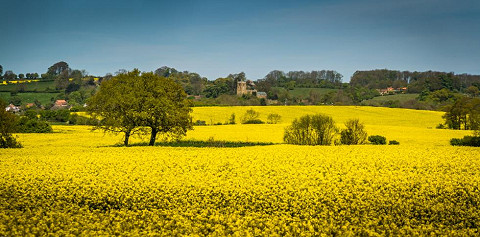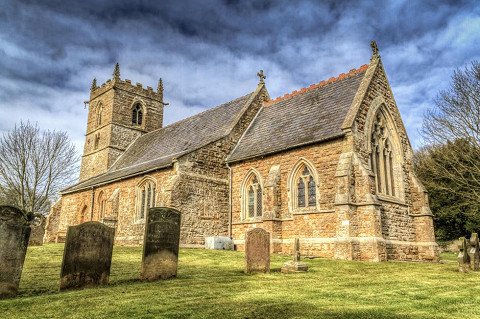- Map
- Listing
Market Rasen's Churches
Find out more about the churches in and around Caistor/Market Rasen

St Peter & St Paul
St Peter & St Paul's church welcomes you through one of the most impressive Norman doorways in the country. Photo by explorechurches.org.
Explore
All Saints
This fine Victorian church has a gallery, a rare early organ, a medieval stoup and a fascinating bell tower including 15th century bells. Fine stained glass windows depict ‘love, hope and charity’. Photo by explorechurches.org
Explore
Wragby Methodist
Wragby Methodist Church celebrated its centenary in 1994, but is the third chapel on this site. The church was built in 1894 and is typical of the late 19th century / Edwardian style. Photo by explorechurches.org
Explore
St Peter & St Lawrence
A lovely village church with interesting features to be discovered including early 14th century stained glass depicting three medieval family shields of the Percy, Umfraville and Beaumont families. Photo by explorechurches.org
Explore
St Mary
A local custom here is that the church gates are closed and tied with twine whilst a couple are being married in the church and untied after the groom has lifted his bride over the gates; this symbolising the beginning of a happy life together. Photo by explorechurches.org.
Explore
All Saints
The old church of All Saints has become a place of pilgrimage and is popular for ramblers, hence the adopted name of The Ramblers Church. Photo by explorechurches.org.
Explore
All Saints
Tealby is well known for its connection to Alfred Lord Tennyson and the Viking Way passes near the church and many walkers take time to enjoy our rural location and to visit the church to experience its peace. Photo by explorechurches.org.
Explore
St Lawrence
Nothing about the rather unremarkable exterior of this small Medieval church prepares you for the breathtaking surprise of the interior of this wonderful church. Photo by explorechurches.org.
Explore
St Peter
St Peters church is used regularly for worship and the harvest festival and carol services are particularly popular, drawing visitors from the area as a whole. Photo by explorechurches.org.
Explore
St Peter
A peaceful and unspoilt church with an appealing simplicity. The solid rustic tower is from the 12th century or even earlier, and the rest of the church dates mainly from the 13th and 14th centuries. Photo by explorechurches.org.
Explore
All Saints
Set in a lovely rural hamlet on the edge of the Lincolnshire Wolds, grade I listed All Saints is a gem of a church, with a wonderful chancel and its connections with Italy. Photo explorechurches.org.
Explore
St Mary
The church stands in the grounds of the Hall, which was and still is the home of the Heneage family and the chancel and north chapel contain an unparalleled and virtually unbroken sequence of family monuments dating from the 15th century. Photo by explorechurches.org.
Explore
St Peter
This tiny church, in a tiny parish, has been unchanged over the centuries. But it does have a story to tell, far more powerful and shocking than its rural setting belies. Photo by explorechurhces.org.
Explore
All Saints
The Polish Air Force and Royal Air Force served nearby at the former RAF Faldingworth and this is commemorated throughout the church including in a stained glass window and the porch gates. Photo by explorechurches.org
Explore
St Michael
This church is one of the few remaining buildings remaining on the site of a deserted medieval village. Apart from its square tower, the church was rebuilt in brick in 1835. Photo by explorechurches.org.
Explore
St Michael & All Angels
Brookenby church was created out of the former unmarried sergeants accommodation on the former RAF Binbrook. Photo by explorechurches.org.
Explore
Market Rasen Methodist Church
Described as an 'immensely impressive classical style non-conformist chapel'. Of particular note are the Ionic pillars and pediment.
Explore
Holy Rood
A Roman Catholic Church which was largely rebuilt in the 1860s which incorporates the volume and west wall of Willson’s church of 1824.
Explore
St Thomas
There has been a church building on this site for over 800 years. The earliest written evidence we have for it dates from the mid 12th century when Thomas of Saleby gave the church to the priory at Sixhills.
Explore
St Cornelius
The church is a grade I listed building with a grade II listed cross in the church yard. Dating back from the 12th century, it is built form coursed and square ironstone rubble with Ashlar dressing, slate roof with stone coped gables. The tower dates back to the 14th century with moulded parapet with Gargoyles, which house two medieval bells, the spire with Lucerne’s was built later than the tower. The nave is 14th century three bay arcade with octagonal piers plus one bay south chapel. Photo by Push Creativity.
Explore
